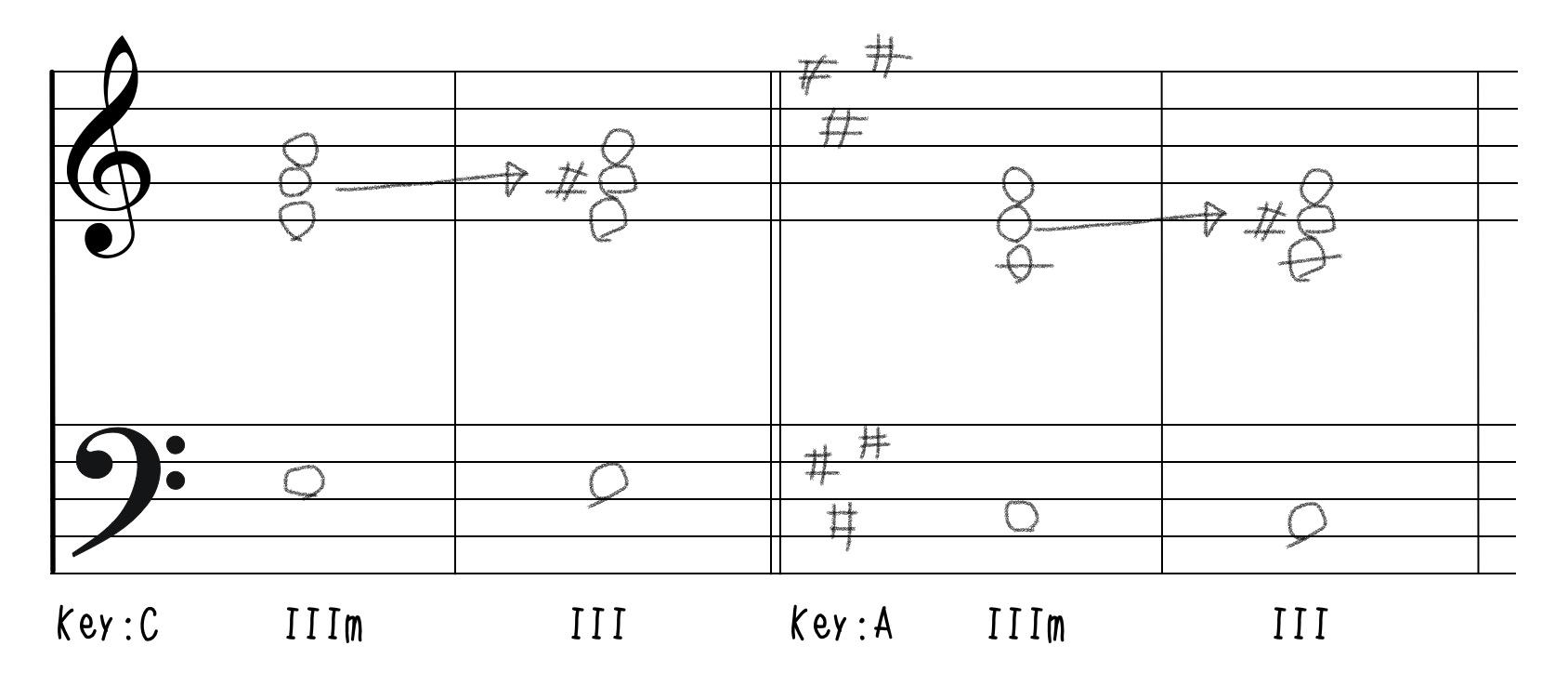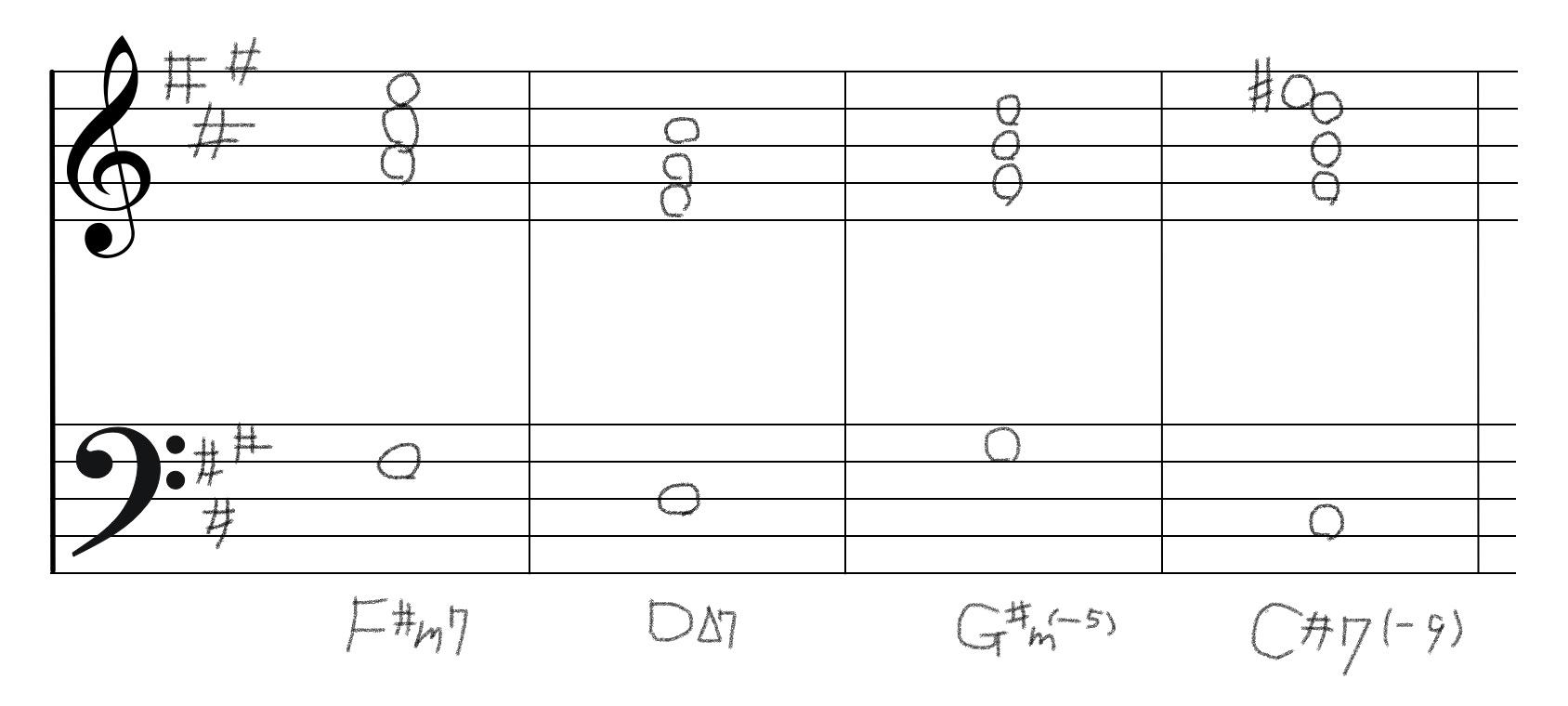Forum Replies Created
-
AuthorPosts
-
Amachan @amachan
Thank you for the detailed explanation! It’s fascinating how practical playing and theory are linked. Also, the Ferris wheel-like diagram is really fun and a great idea. I’m gonna explore various scales arranged in a circular fashion.
Amachan @amachanOn improvisation, what scales do you play on this chord?
Let say in C minor key, Neapolitan Sixth is D♭/F. Since D is flattened, one candidate is definitely Phrygian. Alternatively, you may raise the 7th from it to make the leading tone like the harmonic minor manner, which is called a “Neapolitan Minor” scale.
 Amachan @amachan
Amachan @amachanFirstly, simply put, it’s worth giving names to things that frequently appear in specific forms (contexts). This is especially true for the sake of convenience in analysis.
For example, in jazz, you might call the IVm-♭VII7 motion a “backdoor ii-V“, which is simply a type of modal interchange. The “Coltrane Change” and “So What voicing” are similar cases.
The Neapolitan chord is a famous chord frequently found in classical music especially in the 18th century, also appearing in works by composers like Chopin and Beethoven. So it naturally deserves a name given its recurrent use as a prominent harmonic device.Musically, the Neapolitan chord can be interpreted as a modal interchange, but is unique in two respects:
1)Typically played in its first inversion. In the key of Am, for instance, it would be B♭/D. The fact that it’s not just B♭ is crucial. (And this form is particularly called a “Neapolitan Sixth”.)
2)Placed before the dominant chord in a minor key. In the key of Am, it forms progressions like B♭/D→E7 or B♭/D→Am/E→E.Thus, it is characteristic that it is utilized as a substitute for Dm, the minor subdominant, due to the bass being D.
You can rarely find other non-diatonic chords that is typically used in inversion. The Neapolitan sixth chord stands out in this regard.Amachan @amachanSheet music is not merely a system for indicating where to press the keys. It functions as a message card that communicates what is happening musically. It might be helpful to compare it side by side with the key of C.

In solfa terms, the quality change from IIIm to III involves so turning into so♯, meaning the fifth note of the key is raised by a semitone. In the key of A, this corresponds to E becoming E♯. Calling it F would imply that the note originally was F♯ and has been lowered to F, which doesn’t accurately represent what happens during the transition from IIIm to III in this context.
Amachan @amachanNice groove! OK, there’re many patterns of a melody conflicting with a chord. Here’s the chord progression of the electric piano loop:

In A major key degree, this is 6-4-7-3 progression.
The first two chords get along well with the brass melody. But on the third chord, melody is like “C♯-B-A, A-B-C♯” while chord root is G♯. Both C♯ and A are non-chord tones and A is especially dissonant when ringing over G♯. So the phrase starts and end with unstable relationship.
Or in a macro perspective, the chord, G♯m(-5) creates strong instability in tonality, while the melody is composed mostly of stable tones. Therefore, to simplify, it can be said that it’s not ideal when the intention to stabilize or destabilize the music diverges between the melody and the chords at this point (though it’s not always a bad thing).Then the last chord, this is an intensified version of quality-changed III chord. It involves accidental sharp—E is raised to E♯. Despite this, the melody progresses from F♯ to E, sounding the notes a semitone above and below E♯ in succession. This creates a significant dissonance, which feels mismatched with the chord progression. This is clashes between the notes in the key and the note outside the key, so it may feel even more intense dissonance than that on the third chord.
Sample loops often utilize notes outside of the key. Therefore, even though the samples should theoretically match according to the key labels, they may sound dissonant when layered together.
Amachan @amachanThe context is crucial when analyzing a piece of music. It’s only when considering the surrounding elements that the analysis makes sense.
For instance, interpreting the chord progression C-F-G-C as I-IV-V-I relies on the overall structure. Simply isolating F alone doesn’t reveal the key it belongs to.Now look at the 2nd and 3rd bar; C♮ is used. This strongly indicates that the song is in principle based on natural minor rather than harmonic/melodic minor.
And of course, in the 1st bar, the note C♯, which determines the melodic minor, is not sounding. What can be observed is just that B♭ has changed to B♮.
With C♮ sounding in the vicinity while C♯ is not, in such a situation, it’s reasonable to consider the scale at this moment in G/D as Dorian.Strictly speaking, since C♯ appears in the 7th bar, it’s not impossible to argue for the melodic minor in the G/D of the 5th bar. However, there are two points where the analysis lacks a bit of rigor:
1)The 5th measure clearly intends to repeat the 1st measure. Furthermore, the Dm7 at the beginning contains a C natural. In this context, stating that “the scale switches to melodic minor from the third beat” gives a rather patchy impression and is not a very elegant interpretation.
2)Please pay attention to the movement of the melodic note B♮. In the following bar, this note leaps down to G. The most typical movement of the 6th note in melodic minor is to ascend sequentially and return to the tonal center. Also, in melodic minor, it is a basic manner not to sharpen notes when descending.
With these premises in mind, the movement from B♮ to G appears not at all characteristic of melodic minor, but rather reminiscent of Dorian.
Amachan @amachanHas there been any discussion regarding the relationship between the harmonic series and tonal tendencies like this?
Yes. For example, this is clearly mentioned in “Great Songwriting Techniques,” which is one of the references on this site:
The stability or instability of each tone is measured by each of the tones’ place in the harmonic series. Those closest to the fundamental are the most stable.
(Perricone, Jack. Great Songwriting Techniques (p.87). Oxford University Press. Kindle Edition.)
The overtone series also serves as the basis for the stability of major chords, so it can be said that the stability of each tone can also be considered as either the development or the source of that theory.
Amachan @amachanIn the first movement of Ravel’s String Quartet in F major, the second theme is presented in D minor key during the exposition(1:55) and in F major key during the recapitulation(6:15), with the melody maintaining fixed pitches. As the relative keys involves no difference in key signatures, this could seem a bit simple way of retonalization, but just for your reference.
-
This reply was modified 1 year, 9 months ago by
 Amachan.
Amachan.
Amachan @amachanSo V7 is casually exchanged to V7(-5)?
Basically yes. But as the note Re♭ prompts resolution to Do, I think it’s good to make it progress to the I chord.
One extra note: For melody you should avoid using natural Re as it conflicts with Re♭, but Ditto is a rare case where the melody sometimes hits Re while the chord plays Re♭, for whatever reason, maybe to keep the melody line natural.
Amachan @amachanIt’s E7 with fifth flattened, which is notated as E7(-5). The chord website probably simplified the chords for ease of playing, which is kinda common practice.
By flatting fifth, the note B becomes B♭—In solfa, Re becomes Re♭. Theoretically it strengthens the pull toward the tonal center. And, of course, being a note outside the key, this also provide an intriguing ear-catching stimulus.
Such chords are called “altered dominants”, explained in the chapter V of Chord edition, though not translated yet.
-
This reply was modified 1 year, 10 months ago by
 Amachan.
Amachan.
Amachan @amachanAlternatively, select the preferable range in arrange area and press Ctrl-J. The clip will be expanded and the loop button is automatically turned off.
Wow, this is great! thanks☺️
-
This reply was modified 1 year, 9 months ago by
-
AuthorPosts